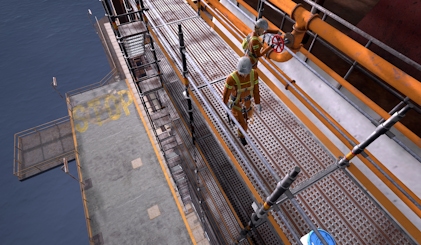In the shock waves of a global pandemic, there’s a collective realization of how much can be done remotely. Sure, it’s not quite the same as being together in person. For many, it feels like a compromise, a temporary solution for the inability to go into the office and work as usual. The 2D solutions widely used today — video conferencing and cloud collaboration tools — attempt to compensate for the physical distance, like taping the engine back together and being relieved the car still runs.
3D immersive software doesn’t compensate, it enhances. It has the potential to expand our life and opportunities, allowing us to accomplish and experience much more, not just in work but in many other areas of society that affect our future as humans.
We just don’t realize it yet.
Underestimating immersive technology
Most people underestimate VR because they haven’t experienced the high-quality immersive versions, the versions that can trick their brain. The technology and equipment are still accessible to most people. History has shown that the true potential of a technology is revealed at the point of scalable production when complexity, price, and size are reduced.
Plus, even today’s highest quality offerings represent VR in its infancy, as it evolves to incorporate all five of our senses. Streaming capability and visual quality are steadily improving. Innovations in sound (spatial audio), touch (haptic gloves), smell, and taste (multisensory masks) will eventually converge to create fully immersive virtual experiences that anyone can access.
Not only is the technology itself underestimated, so are its potential benefits.
The future of work
Starting with the obvious application, immersive software will revolutionize how we work, on an individual and organizational scale.
Virtual workspaces could be augmented and customized in ways no real-world budget could afford. A designer could have five monitors of any size, in a corner office with floor-to-ceiling windows overlooking Mount Kilimanjaro. Teams could meet in a Manhattan conference room in the morning, then on a Shanghai rooftop for happy hour. Why not?
As for the remote team meetings we know today, people lament the loss of in-person communication, all the unspoken cues that are crucial to understanding each other, such as body language and microexpressions. 3D immersive technology will capture all of this and more. Imagine all the data about a teammate or project displayed just above your line of sight, ready to reference. Workplace culture would be not just maintained but actually strengthened.
This is where remote work is headed. Of course, we haven’t forgotten one of the biggest perks...
No longer constricted by time, location, or mobility
Time is our most valuable resource. Daily commutes and regular business trips — traveling for work eats up time. With the power of immersive technology, we could all kiss our commutes goodbye and settle down where we want, without sacrificing our quality of life.
No longer reliant on cities, we could live on the beach or tucked away in the mountains. Our lives could incorporate everything and everyone we want, from anywhere. We could go to a virtual cinema or museum with friends that live around the world, for example. We’d be ‘physical distancing’ without the psychological side effects, because our social and emotional needs would be met through the lifelike interactions in the immersive experience.
A benefit to the environment
During COVID, we glimpsed some environmental benefits from dramatically reduced travel: less pollution, improved air quality. Once immersive technology is widely adopted, the amount of waste will shrink, too. We could try products, toys, race cars in a virtual world, without needing the physical version of the object. Indeed, our entire concept of ‘consumption’ will change.
The fact is — the more we rely on the virtual world to satisfy our economic needs, the better we preserve the physical world that we love.
Improved education
Finally, one of the most consequential benefits of immersive technology (closest to our hearts at Pixaera) is the potential to expand access to high-quality education.
Kids learn through doing, especially through play. What if they could access magical worlds, designed with intelligent 3D interactions that help them grasp powerful concepts like trust, confidence, communication, problem-solving, empathy, commitment, and hard work? Immersion triggers emotions, emotions build depth, and break belief patterns. The physical schooling system is limited in quality, scope, and reach, barely providing such lessons to the students it does cover, never mind the ones it overlooks. At scale, immersive technology in education could uplift individual lives and entire societies.
The future is immersive
With immersive technologies, the world opens up and multiplies, becomes limitless and borderless. At the same time, the technology lets us choose our own little niche on the planet, designing our lives to suit ourselves, not our obligations. When built with the right positive intent, the virtual spaces we create will amplify our abilities to experience, connect, protect, and educate. What’s more human than that?



